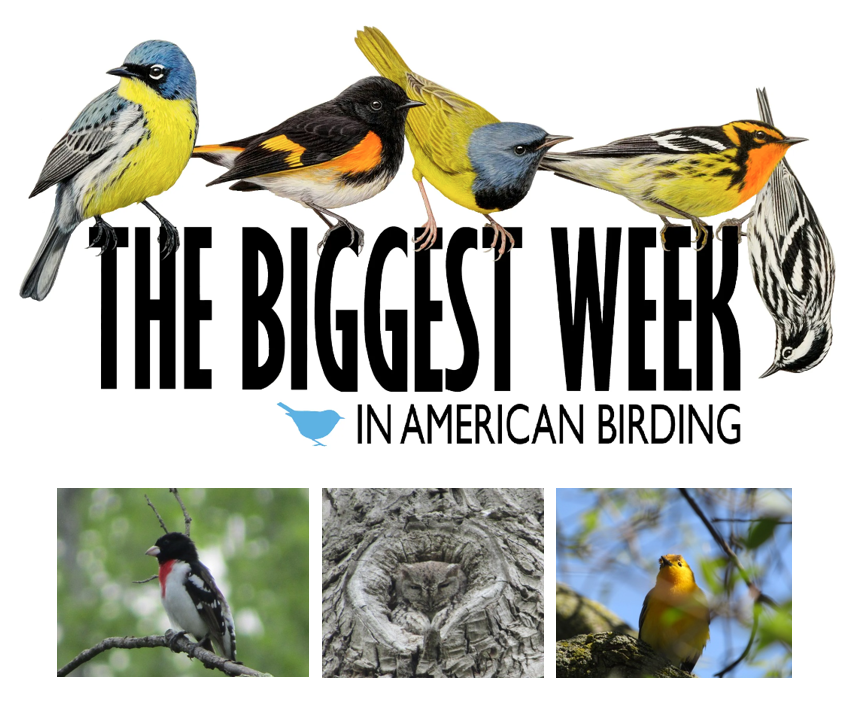
“The Biggest Week in American Birding” – A Trip in May to See Central Flyway Migrants
By Bonnie Wood
“Blackburnians dripping off the trees.” With these words, a birder we encountered a few years ago enticed us to bird Ohio’s Lake Erie western shore during May migration. With COVID-19 waning (?), we planned a trip to Magee Marsh, a preserve on the western Lake Erie shore of Ohio, which each year holds a festival billed as “The Biggest Week in American Birding.” Magee Marsh and other Great Lakes shorelines attract northward migrating birds who stop at the southern edges of the Great Lakes to rest and fuel up before moving on to their nesting territories in Canada. I have seen the phrase “bird trap” used to describe these sites. Scheduled in May to coincide with the Central Flyway’s migration peak as much as possible, the Magee Marsh festival attracts thousands of birders who, like us, wish especially to see Central Flyway warblers and other songbird migrants not normally seen west of the Rockies. There were birders there with camera lenses as long as a football field; there were others with babies in strollers taking pictures with their phones.
But this year, Magee Marsh was not the same as before Covid forced the festival’s two-year hiatus. In the fall of 2021, a freakish windstorm took down over 50 trees which used to shade the “famous” Magee Marsh boardwalk. We, having never been there, didn’t know the difference, but one birder we chatted with said, “I cried when I arrived and saw what happened.” He added, “I’ve come here for twelve years and never gotten a sunburn.”
Given the damage, it was considered a miracle that the boardwalk was repaired enough in time for the festival. We planned to be there for just the last two days of the festival, so that local experts would be there from whom we could learn the different warblers. We did learn lots and saw lots, but the crowds were oppressive sometimes. At times, one could move neither forwards nor backwards, as folks stopped and strained to see warblers in the shrubs and understory. With the shade trees gone, too, birding the boardwalk on sunny days was hot.
Hot, yeah, but we saw these warblers, all Central Flyway migrants new to us:
Blackburnian Warbler (not “dripping off the trees” for us – yet we did see two clearly)
Cape May Warbler
Bay-Breasted Warbler
Chestnut-Sided Warbler
Black-Throated Blue Warbler
Black-Throated Green Warbler
Prothonotary Warbler
Magnolia Warbler
Canada Warbler
Tennessee Warbler
Northern Parula
American Redstart
Mourning Warbler
Northern Waterthrush
Blackpoll Warbler
Blue-Winged Warbler
Nashville Warbler
On the first day we were there, we overheard one birder say he’d seen an endangered Kirtland’s Warbler at the end of the boardwalk. No one else saw it.
Warblers who also frequent Western Washington were present in force. Yellow Warblers, particularly, are a common bird in Ohio. “What’s that?” “Oh, just another Yellow.” Wilson’s Warbler, Yellow-Rumped Warbler, and Common Yellowthroat were also numerous.
Other midwestern and eastern birds excited us Western Washingtonians: Scarlet Tanager, Rose-Breasted Grosbeak, Indigo Bunting, neon-orange Baltimore Oriole, Red-Headed Woodpecker, three species of vireo, Eastern Screech Owl, Black-Billed Cuckoo, Veery, Wood Thrush, Yellow-Breasted Chat and more. Those of us who grew up east of the Rockies will know many of the birds we saw, yet others were strictly midwestern species.
I cannot say if the warbler-hunting on the Magee Marsh boardwalk was handicapped by the loss of trees, if warblers chose to rest up elsewhere before the trip across the Great Lakes. Apparently 35 species of warbler migrate through Ohio on the Central Flyway (see the excellent website https://birdwatchinghq.com/warblers-in-ohio). Of course, hitting the exact day or week specific birds will appear is impossible. So, no “Blackburnians dripping off the trees” for us. But still. We may not have seen 35 warbler species, but we’ve no complaints.
Along Lake Erie’s Ohio shore, moving east from Toledo, one finds one great birding site after another, easily accessed and birded. Maumee Bay State Park, Howard Marsh, Metzger Marsh, Ottawa National Wildlife Refuge, Blackwater Swamp, and Magee Marsh stretch along the lakeshore. Although waterfowl were mostly gone in mid-May, we did see at Howard Marsh a flock of Black-Bellied Plover in vivid summer colors. Sandhill Cranes flew overhead. A Horned Lark foraged in the parking lot. Many birders came to Howard Marsh while we were there eager to see… Yellow-Headed Blackbirds.
Southwest of Toledo, not far, another marvelous birding site deserves mention: Oaks Opening Metropark’s miles of walking and bicycling paths that lead through diverse habitats: deciduous woods, meadows, riparian borders, and wetland.
“Fishin’ or birding?” is how the clerk at our first hotel in Port Clinton, the “Walleye Capitol of the World”, greeted us. There for a couple of days, we then moved to an Airbnb rental in Oregon, Ohio, minutes’ drive from the marshes. Rentals minutes away from the birding sites were also available in the tiny farm towns of Curtice and Bono.
All in all, we saw many, many birds we would not see in Washington, and we saw many, many birds we do see in Washington. We saw many birds I knew from growing up on the East Coast. If you seek warblers, however, Ohio’s Lake Erie shore in May, or other Great Lakes birding hotspots, are great places to explore.
Photo credit: The Biggest Week in American Birding logo, with photos of a Rose-breasted Grosbeak, Eastern Screech-Owl, and Prothonotary Warbler by Bonnie Wood.







